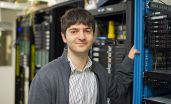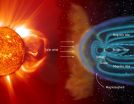The Rosetta spacecraft caught up with the comet known as 67P/Churyumov-Gerasimenko beyond Mars this August, and its preliminary results--along with the studies it will allow in the near-future--top this year's list of the most important scientific breakthroughs, according to the editors of Science.
This annual list of groundbreaking scientific achievements, selected by Science and its international nonprofit publisher, AAAS, also includes groundbreaking advances in medicine, robotics, synthetic biology, and paleontology, to name a few.
The top-10 list for 2014 appears in the 19 December issue of the journal along with a related news feature and multimedia component.
Rosetta and its lander module, known as Philae, made major headlines in November when Philae touched down on the surface of the speeding comet. Even though the landing was rougher than expected--Philae bounced off the unforgiving surface of 67P and came to rest on its side, quite a distance from its target--it was nonetheless the first-ever soft landing on a comet. And the data from these two space probes are already shedding new light on the formation and evolution of such comets.
"Philae's landing was an amazing feat and got the world's attention," said Tim Appenzeller, news editor of the journal Science. "But the whole Rosetta mission is the Breakthrough. It's giving scientists a ringside seat as a comet warms up, breathes, and evolves."
Launched in March, 2004, by the European Space Agency (ESA), the Rosetta spacecraft is now orbiting 67P, sometimes getting as close as 6.2 miles (10 kilometers) to the comet's surface. Its on-board camera can discriminate between objects on the comet that are just centimeters apart while an array of spectrometers, known as the Rosetta Orbiter Sensor for Ion and Neutral Analysis (ROSINA), can sample gases from 67P's coma, or the thin halo of an atmosphere that surrounds the comet.
ROSINA has already detected water, methane, and hydrogen as well as some rarer species, including formaldehyde and hydrogen cyanide, in 67P's coma. Such findings might help researchers figure out whether certain comets could have have helped to jump-start life on the early Earth by delivering water and organic molecules. In December, a report published by the ROSINA team revealed an exceptionally high ratio of heavy hydrogen (deuterium) to regular hydrogen, suggesting that comets like 67P, which hail from the Kuiper belt--a region beyond Neptune--could not have made such water deliveries.
"Breakthroughs should do one of two things: either solve a problem that people have been wrestling with for a long time or open the door to a lot of new research," said Robert Coontz, deputy news editor at Science. "In this case, most of the really good science lies ahead."
By keeping their eyes on the jets of gas and dust trailing behind 67P, researchers may eventually learn how comets evolve as they approach the sun. Then, by working backwards, researchers could turn back to the clock and perhaps glean how various comets formed some 4.5 billion years ago.
The currently-dead batteries on Philae might recharge as the comet gets closer to the sun, but even if they don't ESA mission managers have suggested that 80% of all the science will come from the mother ship, Rosetta, anyway. Peak activity on the spacecraft should occur in August, 2015, they say, when 67P is halfway between the orbits of Earth and Mars--and as close to the sun as it gets.
In addition to the nine runners-up for this year's Breakthrough of the Year, the staff of Science also describes areas to watch--Arctic sea ice and combined immunotherapy, for example--as well as the year's major breakdown--the response to West Africa's Ebola outbreak--and the results of a readers' choice poll in which the public voted on its own breakthroughs.
In addition to the nine runners-up for this year's Breakthrough of the Year, the staff of Science also describes areas to watch--Arctic sea ice and combined immunotherapy, for example--as well as the year's major breakdown--the response to West Africa's Ebola outbreak--and the results of a readers' choice poll in which the public voted on its own breakthroughs. Once the embargo lifts, this year's list of breakthroughs will appear in the journal along with a related news package and a podcast at http://www.sciencemag.org/special/btoy2014/ or http://scim.ag/breakthru14. A YouTube video will also be available at http://scim.ag/breakthru14vid. The journal's list of nine other major scientific achievements of 2014 appears below in no particular order.
The Dinosaur-Bird Transition: This year, a series of papers that compared the fossils of early birds and dinosaurs to modern birds revealed how certain dinosaur lineages developed small, lightweight body plans, allowing them to evolve into many types of birds and survive the Cretaceous-Paleogene Extinction about 66 million years ago.
Young Blood Fixes Old: Researchers demonstrated that blood from a young mouse--or even just a factor known as GDF11 from young mouse blood--can rejuvenate the muscles and brains of older mice. The findings have led to a clinical trial in which Alzheimer's patients are receiving plasma from young donors.
Getting Robots to Cooperate: New software and interactive robots that, for example, instruct swarms of termite-inspired bots to build a simple structure or prompt a thousand quarter-sized machines to form squares, letters, and other two-dimensional shapes are proving that robots can work together without any human supervision after all.
Neuromorphic Chips: Mimicking the architecture of a human brain, computer engineers at IBM and elsewhere rolled out the first large-scale "neuromorphic" chips this year, which are designed to process information in ways that are more akin to living brains.
Beta Cells: Two groups pioneered two different methods for growing cells that closely resemble beta cells--the insulin-producing cells of the pancreas--in the laboratory this year, giving researchers an unprecedented opportunity to study diabetes.
Indonesian Cave Art: Researchers realized that hand stencils and animal paintings in a cave in Indonesia, once thought to be 10,000 years old, were actually between 35,000 and 40,000 years old. The discoveries suggest that humans in Asia were producing symbolic art as early as the first European cave painters.
Manipulating Memory: Using optogenetics--a technique that manipulates neuronal activity with beams of light--researchers showed that they could manipulate specific memories in mice. Deleting existing memories and implanting false ones, they went so far as to switch the emotional content of a mouse memory from good to bad, and vice versa.
CubeSats: Although they've been blasted into space for more than a decade now, cheap satellites with sides that are just 10 centimeters squared, called CubeSats, really took off in 2014. Once considered educational tools for college students, these miniature satellites have started to do some real science, according to researchers.
Expanding the Genetic Alphabet: Researchers have engineered E. coli that harbors two additional nucleotides--X and Y--in addition to the normal G, T, C, and A that make up the standard building blocks of DNA. Such synthetic bacteria can't reproduce outside the laboratory, but they may be used to create designer proteins with "unnatural" amino acids.
INFORMATION:
The American Association for the Advancement of Science (AAAS) is the world's largest general scientific society and publisher of the journal Science as well as Science Translational Medicine and Science Signaling. AAAS was founded in 1848 and includes 254 affiliated societies and academies of science, serving 10 million individuals. Science has the largest paid circulation of any peer-reviewed general science journal in the world, with an estimated total readership of 1 million. The nonprofit AAAS is open to all and fulfills its mission to "advance science and serve society" through initiatives in science policy, international programs, science education, public engagement, and more. For the latest research news, log onto EurekAlert!, http://www.eurekalert.org, the premier science-news Web site, a service of AAAS.

